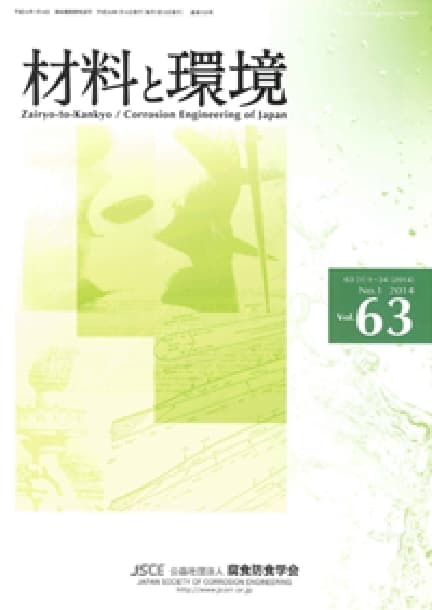- TOP
- Zairyo-to-Kankyo
- Vol. 66 (2017), No. 2
Zairyo-to-Kankyo Vol. 66 (2017), No. 2
Backnumber
-
Vol. 74 (2025)
-
Vol. 73 (2024)
-
Vol. 72 (2023)
-
Vol. 71 (2022)
-
Vol. 70 (2021)
-
Vol. 69 (2020)
-
Vol. 68 (2019)
-
Vol. 67 (2018)
-
Vol. 66 (2017)
-
Vol. 65 (2016)
-
Vol. 64 (2015)
-
Vol. 63 (2014)
-
Vol. 62 (2013)
-
Vol. 61 (2012)
-
Vol. 60 (2011)
-
Vol. 59 (2010)
-
Vol. 58 (2009)
-
Vol. 57 (2008)
-
Vol. 56 (2007)
-
Vol. 55 (2006)
-
Vol. 54 (2005)
-
Vol. 53 (2004)
-
Vol. 52 (2003)
-
Vol. 51 (2002)
-
Vol. 50 (2001)
-
Vol. 49 (2000)
-
Vol. 48 (1999)
-
Vol. 47 (1998)
-
Vol. 46 (1997)
-
Vol. 45 (1996)
-
Vol. 44 (1995)
-
Vol. 43 (1994)
-
Vol. 42 (1993)
-
Vol. 41 (1992)
-
Vol. 40 (1991)
Keyword Ranking
23 Dec. (Last 30 Days)
Zairyo-to-Kankyo Vol. 66 (2017), No. 2
Development of Artificial Rainfall Equipment for Studying the Effect of Rain on the Corrosion Behaviors
Dara To, Tadashi Shinohara, Osamu Umezawa
pp. 58-61
DOI:
10.3323/jcorr.66.58Abstract
Atmospheric corrosion is an electrochemical process which can only proceed in the presence of an electrolyte film. Rain is one of the main factors in initiating the time of wetness and transporting the chemical substance from the atmosphere to metal surface that guide to accelerate the corrosion attack. In this case study, an artificial rainfall equipment was developed with the aim of defining the behaviors of atmospheric corrosion which is affected by rain and chemical species. The Atmospheric Corrosion Monitoring (ACM) sensor which consists of a Fe-Ag couple was used to measure the corrosivity of the rainfall solution by finding the relation between the Corrosion Rate (CR) and the sensor output. The controllable precipitation rate and its distribution facilitate in investigating the effect of rainfall on the corrosion behaviors. The relation between the sensors output and CR enable to predict the corrosivity of the atmosphere. Thus, the developed artificial rainfall equipment is an essential and reliable tool for studying the corrosion behaviors under the effect of rain.
Analysis of Water Chemistry Change Behavior of the Spent Fuel Pool Due to the Injection of Sea Water and/or Fresh Water to the Fukushima Daiichi Nuclear Power Station of Tokyo Electric Power Company
Masayoshi Ozawa, Masatsune Akashi
pp. 62-70
DOI:
10.3323/jcorr.66.62Abstract
Concentration of SO42- and HCO3- which affect to corrosion for carbon steels were estimated by analysis using pH, Cl- concentration and electrical conductivity κ, in the spent fuel pools (SFP) of Fukushima Daiichi Nuclear Power Station (1F) in which sea water and/or fresh water were injected. Electrical conductivity κ in the SFP of 1F Unit 1 in which fresh water was injected, were presumed accurately by analysis using observed Cl- concentration, concentration of SO42- and HCO3- which were estimated. The pH measurements exceeded the estimate in 1F Units 2 and 3 where sea water was injected. Each of dissolution reaction of iron, dissociation of H4N2, and the production of ammonia by the decomposition of H4N2 has been evaluated as not the cause of the high pH by itself. It was estimated that the calcium ions from the concrete debris had been continuously supplied to water in SFP of the unit 3 during purification treatment period. It was evaluated that self-passivation conditions of carbon steel were achieved in the water chemistry after the purification process completed for the Fukushima Daiichi Nuclear Power Station of Units 2 to 4. In addition, it was evaluated that self-passivation of carbon steel was achieved in the environment of unit 1.
Article Access Ranking
23 Dec. (Last 30 Days)
-
Delayed Fracture Mechanism of 1700 MPa-Class Quenched and Tempered Bolt under Atmospheric Corrosion Environment
Tetsu-to-Hagané Advance Publication
-
Perspectives on the Promising Pathways to Zero Carbon Emissions in the Steel Industry toward 2050
ISIJ International Vol.65(2025), No.2
-
Effect of B on Surface Oxidation Behavior and Phosphatability of Si-Mn-added Cold-Rolled Steel Sheets
ISIJ International Advance Publication
-
Factors Influencing the Bonding Phase Structure of Iron Ore Sinters
ISIJ International Vol.43(2003), No.9
-
Effect of microstructural heterogeneity on fatigue limit of as-quenched low-carbon low-alloy martensitic steel
ISIJ International Advance Publication
-
Prussian blue as a fully reversible hydrogenochromic material for visualizing hydrogen distribution in Fe sheet
ISIJ International Advance Publication
-
Metallurgical Aspects on Interstitial Free Sheet Steel From Industrial Viewpoints
ISIJ International Vol.34(1994), No.1
-
Abnormal Grain Growth Behavior of Ferrite in Pure Iron with Cold Torsion
Tetsu-to-Hagané Advance Publication
-
Influence of Antimony on the Oxidation Characteristics of 65Mn Steel
ISIJ International Advance Publication
-
From plasticity to fracture in pearlitic microstructures: Atomistic study of cementite thickness and deformation localization
ISIJ International Advance Publication
You can use this feature after you logged into the site.
Please click the button below.










